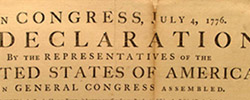 On Sunday night at 8 p.m. EST, The History Channel will premier “The People Speak,” a two-hour special heavily based on Howard Zinn’s A People’s History of the United States. Zinn, who could be called “America’s favorite radical left-wing college professor” because of the success of his book, also hosts and narrates the show. The History Channel Web site touts the special as a broadcast that “gives voice to those who spoke up for social change throughout U.S. history, forging a nation from the bottom up with their insistence on equality and justice.” Hollywood stars such as Matt Damon, Christina Kirk, Marisa Tomei, and James Brolin read the words of Americans well-known and obscure who “stood up for liberty.”
On Sunday night at 8 p.m. EST, The History Channel will premier “The People Speak,” a two-hour special heavily based on Howard Zinn’s A People’s History of the United States. Zinn, who could be called “America’s favorite radical left-wing college professor” because of the success of his book, also hosts and narrates the show. The History Channel Web site touts the special as a broadcast that “gives voice to those who spoke up for social change throughout U.S. history, forging a nation from the bottom up with their insistence on equality and justice.” Hollywood stars such as Matt Damon, Christina Kirk, Marisa Tomei, and James Brolin read the words of Americans well-known and obscure who “stood up for liberty.”
As both an American and historian, I am all for standing up for liberty, justice, and self-determination, ideas that President
Obama recently praised as advancing across the world. However, I am not sure that Howard Zinn’s view is one worth standing up for. Zinn’s book, though a best-seller that graces home libraries and Advanced Placement U.S. History required reading lists, is based on the idea that he (and he alone) presented a radical and critical view of American history scorned by the Establishment. That alone is astounding claim considering that anyone who currently teaches social studies in a public school probably has dozens of lessons plans that present U.S. history from the bottom up. The average student at a public university probably has a majority of professors who see U.S. history as a discipline that must be taught from the point-of-view of race, class, and gender studies. Viewing American history from the “bottom up” is an inevitability as far as the current Establishment of the discipline is concerned. In addition to what I will decide to call Zinn’s exaggeration, the whole project was bankrolled by the insufferable Matt Damon. Damon as a presence and force behind the special doesn’t exactly strike me as the Mark of Quality considering his skills as a historical interpreter of World War I on display in “The Legend of Bagger Vance.”
Beyond that, Zinn takes questionable stances that have usually been deemed “revisionist.” The U.S. Constitution? It was established only to protect the property of elites. Abraham Lincoln? He was an open racist who only broached emancipation because it would flood the Republican Party with abolitionist voters. World War II? It was a quest by the United States to seize world economic domination, not a crusade against some of the most evil regimes in world history. (If you doubt my analysis, please consult respectively pp. 89-92 [which is really a rehash of the Beard thesis], pp. 187-190, and pp. 412-414 in the nearest handy copy of A People’s History.) In addition, Professor Zinn has wandered in and out of the camp of the 9-11 “truthers” who insist that the September 11, 2001 attacks on World Trade Center and the Pentagon were a hoax, a U.S. conspiracy, or both. Furthermore, Zinn never answers (or even addresses) a fundamental question: If his thesis of exploitation is correct, why do Americans continue to embrace democratic capitalism and show no sign of rejecting its benefits? One can, of course, debate the merits of his various intellectual and political positions – that is the nature of historical discourse at its most vigorous. As a skeptic of his positions, I would enjoy a show that had him present his arguments and then let various doubting historians and commentators argue with him. I would love Michael Kazin to be on that hypothetical panel because of the following comment alone:
Zinn’s conception of American elites is akin to the medieval church’s image of the Devil. For him, a governing class is motivated solely by its appetite for riches and power–and by its fear of losing them. Numerous historians may regard George Washington and Thomas Jefferson, James Madison, and Alexander Hamilton as astute, if seriously flawed, men who erected a structure for the new nation that has endured for over two centuries. But Zinn curtly dismisses them as “leaders of the new aristocracy” and regards the nation-state itself as a cunning device to lull ordinary folks with “the fanfare of patriotism and unity.”
Obviously, Zinn is not my intellectual cup of tea. When it comes to single-volume histories of the United States that examine the nation thoroughly, critically, but also with an acknowledgement that “the plain fact is this: The United States of America has helped underwrite global security for more than six decades with the blood of our citizens and the strength of our arms,” I prefer work that is more balanced and less ideological. When it comes to two-hour television specials based on New Left ideology and revisionism, I will pass. As for the core audience of The History Channel, I wonder if viewers who recently praised the cable channel for one of the best documentaries about World War II ever produced will stomach his radical positions. If ratings are low, I am sure Zinn will simply say it was the capitalist power elite victorious once again. Of course, the truth might be less conspiratorial: Viewers could simply recognize that Howard Zinn is wrong.





Eric J. Hobsbawm, RIP
Eric J. Hobsbawm, 1917-2012
The New York Times notes the death of Eric Hobsbawm, Britain’s preeminent social and labor historian whose work on capitalism and the lower-class unrest in Europe of “pre-political” road agents, millenarians, levellers, and urban rioters in 18th and 19th century society helped shed new light on the Age of Revolution. He moved historical understanding of the period from solely examining the record through the lens of great men to a close examination of working men and women. An unrepentant Marxist, he only in recent years chose silence regarding his ideology after decades of supporting the Communist Party instead refuting his beliefs, a decision that made him enormously controversial even in left-wing intellectual circles. His politics always baffled me: How can someone remain in the CP when you die at 95, old enough to have witnessed firsthand the depredations of Stalin and the ruthlessness of the Soviets crushing Hungary, Czechoslovakia, and Afghanistan? His own comments on his choice to remain loyal to the party smack of the Red utopianism that has often seduced European and American intellectuals:
The wealth and peace after World War II (the longest period without warfare in the history of Europe since the pax romana) was never what it seemed to be — at least that’s what Hobsbawm indicated through most of his work. Furthermore, he was a dedicated anti-fascist who lived through the rise of Hitler and National Socialism, so I wonder what he did want society to achieve if the defeat of the Nazis wasn’t enough to verify the benefits of democratic capitalism. No matter: Hobsbawm argued that Stalin was the real hero that created the West’s economic expansion, as an obituary in The Telegraph outlines along with other interesting quotes regarding his politics. Nihil nisi bonum. Great minds are often inconsistent minds, but his contribution to reshaping study of Revolutionary America included influencing historians who began to study how riotous behavior in Boston and New York motivated independence as much as ideology. Alas, when you get Marxists or their New Left fellow travelers in the room, someone always starts to talk about class in America — and that’s when I leave the room to find the Consensus Historians all agreeing to go out to the nearest pub. RIP.
Leave a comment
October 7, 2012 · 4:48 am